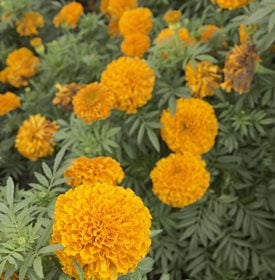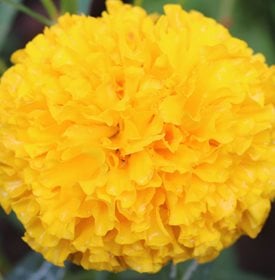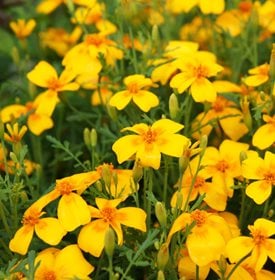Grow Marigolds for No-Fuss Color in the Garden
These annual flowers are easy-to-grow in containers or summer bordersMarigolds are a favorite, no-fuss annual that can bring the color of sunshine to your garden, as well as butterflies, bees, ladybugs, and other beneficial insects. Give them full sun and some well-draining soil and watch them bloom from late spring until fall.
Marigold seeds germinate quickly, within just a few days, and bloom in about 8 weeks. This quick sense of satisfaction makes them a great first-time gardening project for kids and garden newbies. Not to mention, marigolds are a great companion in your vegetable garden and can help protect your veggies from predators and pests.
On this page: Marigold Basics | Planting | Care | Popular Types | Design Tips | Marigolds in the Vegetable Garden
- MARIGOLD BASICS
- PLANTING MARIGOLDS
- MARIGOLD CARE
- POPULAR TYPES
- DESIGN TIPS
- MARIGOLDS IN THE VEGETABLE GARDEN
MARIGOLD BASICS
Zones:
Annual. Marigolds are appropriate for seasonal use in all zones.
Height/Spread:
There are varieties available from 6 inches to 4 feet tall, and 6 inches to 2 feet wide. See ‘Types’ for more specific information on sizes.
Exposure:
Full sun
Bloom Time:
Late spring until first frost
Color:
Marigolds are available in shades of orange and yellow; some with highlights of red, gold, copper or brass.
Types:
There are approximately 50 species of marigold, but the 3 most common are:
- French marigold (Tagetes patula): The most common type found in local nurseries, these range in size from 6 to 12 inches tall and 6 to 9 inches wide. They are compact annuals with double flowerheads up to 2 inches across.
- African marigold (Tagetes erecta): These are the tallest variety of marigolds and range in height from 1 to 4 feet, and have a 1 to 2 foot spread. Their large flowerheads can reach up to 5 inches across, are densely double and pompon-like.
- Signet marigold (Tagetes tenuifolia): Upright annuals that grow up to 12 inches tall and wide. Flowerheads are single and are usually 1 inch in size. The flowers are edible and often used as a bright topper for salads, pasta and vegetables.
Calendula, also called pot marigold, is not related to the common yellow and orange marigolds that most people know, but is an herb often grown for medicinal purposes. Mexican tarragon (Tagetes lucida) is related, but is mainly grown for culinary as well as medicinal uses. Mexican marigold (T. lemmonii) is also related, but is an evergreen shrub.
PLANTING MARIGOLDS
When to plant:
Taller African varieties (Tagetes erecta) should be planted in early spring after all danger of frost has passed. Starting these taller varieties early in the season will allow them more time to grow and mature. French and Signet types (T. patula and T. tenuifolia) can be planted any time from spring through mid-summer.
Where to plant:
Most marigolds prefer to be located in an area with full sun but will tolerate some shade. During times of extreme heat, some afternoon shade is beneficial. T. erecta varieties should be planted in an area protected from strong winds and damaging rainfall. These taller varieties may also require some light staking for support.
How to plant:
Marigolds germinate quickly, sprouting within a few days and blooming in about 8 weeks, making them easy to grow from seed. Sow seeds directly outside after all danger of frost has passed and the soil has begun to warm up. Sow seeds 1 inch apart and water thoroughly after planting. After the seeds sprout, they should be thinned to the following guidelines: French or Signet varieties 8 to 10 inches apart, and African varieties 10 to 12 inches apart. Use landscape scissors or small garden shears to cut the seedlings out, as pulling them out can disturb the roots of the seedlings left behind. Seeds can be started earlier indoors, but with their fast germination time, this really isn’t necessary. Seedlings can be transplanted when 2 inches tall.
When transplanting marigolds purchased at a nursery, dig and loosen the soil about 6 inches down, with the final planting hole just slightly larger than the rootball. Backfill with soil and press firmly into place. Water thoroughly. Adding a 1 to 2-inch layer of mulch between the plants will help keep the soil moist and discourage weeds.
Other:
Marigolds grown in containers can become overcrowded, so be sure to space them accordingly.
Marigold Care
Pruning:
Deadheading (cutting off spent flowers) will improve the appearance of the plant and encourage further blooming later in the season. Pinching young plants will help promote bushier growth. Pinch and remove new growth at the top of the plant as close as possible to the next leaf nodes on the stem.
Soil:
Marigolds aren’t too picky about their soil, but will be their best in moderately fertile, well-drained soil. If planted in clay soil or an area that doesn’t drain well, they may not perform as expected.
Amendments & Fertilizer:
When transplanting, a 5-10-5 fertilizer can be added, but is completely optional. Marigolds grown in-ground generally don’t require any fertilizer. In fact, if fertilizer is applied during the growing phase, it can boost foliage growth at the expense of flower production. Marigolds in containers can benefit from a diluted liquid fertilizer watered in occasionally.
Watering:
It is best to water marigolds at the base of the plant and not from overhead. The densely double flowerheads will tend to rot with excess moisture. Allow the soil to dry somewhat between waterings, but do water regularly in high heat or dry weather. Marigolds growing in containers should be watered daily as containers dry out quickly.
Propagation:
To save seeds, allow the flowerheads to fade and dry intact on the plant. When fully dried, remove the petals and shake out the seeds. Not all flowerheads will produce seeds, but most should. Remember that hybrids will not come true from saved seed.
Diseases and Pests:
Marigolds can be susceptible to gray mold, bacterial leaf spot, powdery mildew and root rot. Pests such as leaf miners or spider mites may also be a problem. Interestingly enough, marigolds also do their fair share of repelling several types of insects. According to the New York Botanical Garden, marigolds can help keep away mosquitoes, aphids, thrips, whiteflies, Mexican bean beetles, squash bugs, tomato hornworms and nematodes.
Other:
Marigolds aren’t on the favorites list for deer, and may even deter them from eating other plants if planted near them—although this theory is not foolproof, as hungry deer have been known to eat just about anything. Rabbits also don’t seem to like the scent of marigolds and will tend to steer clear.
POPULAR TYPES
Design Tips
- Marigolds are an excellent choice for live bouquets. For best results, cut fresh blooms early in the morning and place immediately in water. To help keep the vase water fresh, remove the lower stems and leaves that will be submerged. Expect cut marigolds to last approximately a week, possibly longer if you use a cut flower preservative.
- To dry cut marigolds, cut blossoms at their peak and remove stems and leaves. Hang them upside down in a warm, dry place until they are dry.
- Grow marigolds in containers on patios, porches, or near seating areas to help deter mosquitoes. For more on how to keep mosquitoes away naturally, see 12 Mosquito Repellent Plants.
- Marigolds are suitable for borders near sidewalks and driveways due to their high heat tolerance, although be sure to water them regularly.
- Use marigolds in borders and beds for a bright pop of color all summer long.
MARIGOLDS IN THE VEGETABLE GARDEN
Growing marigolds in or next to your vegetable garden can prove to be quite beneficial in many ways.
- Attract bees and other pollinators, as well as beneficial insects like ladybugs. T. tenufolia ‘Lemon Gem’ is a great choice to attract beneficial insects, and it’s also edible — a win-win for the veggie garden!
- Repel unwanted visitors such as whiteflies, cabbageworms and tomato hornworms. French marigolds are said to be the best choice for this.
- Protect your garden from harmful nematodes that live in the soil. Again, French marigolds can be the best choice.
- Guard your veggies by keeping rabbits and deer from nibbling in your garden, since they tend to not like the scent.
Note that your marigolds’ water needs may be different than those of the vegetables they are planted with so water them separately if needed.
If you are growing an organic vegetable garden, it is best to purchase organic marigold seeds and grow them yourself rather than transplanting nursery-grown or store-bought plants that may have non-organic pesticides and fertilizers in or on them.
RELATED:
25 Best Orange Flowers
Flowers for Bees
Amazing Annuals for Sun
20 Fabulous Fall Flowers











